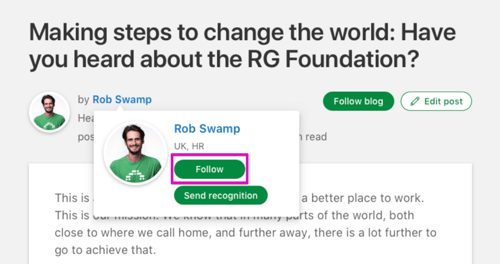Two years ago, Forrester Research said that over 63 million Americans will work virtually, compared to 2010 when there were 34 million flexible and virtual workers. Fast-forward to now and technology has come even further. Year-over-year, this trend will only continue to rapidly grow along with technology’s speed.
It’s likely your organization has an ever-growing offline or remote workforce.

These are the employees who live far away, the field workers whose office is their car or truck, the new moms or dads on maternity or paternity leave, or the ones who simply aren’t in the office as much as others (think work-from-home employees).
Also consider people who work in restaurants, retail, manufacturing and health services and have little direct communication with their managers and team members outside of the physical workplace.
It’s crucial to your organization’s success that your communication and recognition initiatives reach workers who are remote and not at a desk all day. Here are five ways to foster deeper connections with offline employees using technology.
1. Provide central recognition areas
For employees who don’t sit at a desk all day, or have immediate access to a computer, it’s key to create designated stations for connections.
Provide computer kiosks (whether a desktop, laptop or tablet) in central areas that can be easily accessed by employees.
A break room, meeting room or other “public” employee space will work well. As a general rule of thumb, there should be at least one kiosk per location, or one kiosk for every 100 employees.
These kiosks allow your people to take a moment out of their day to access your program to recognize others, catch up on the latest news and join the conversation about the great work going on day-to-day.
This is one way that technology helps improve employee motivation, productivity and engagement to foster a more connected workforce.
.jpg?width=500&name=RG-GBU-36-2018-London_-183%20(2).jpg)
2. Encourage manager participation
Manager participation is a surefire way to increase engagement with your people. If you’ve just implemented a new employee engagement platform, for example, your managers can teach employees the ins and outs of the platform.
This will help them feel comfortable and confident with the basics of logging in, navigating the site, posting recognitions and reading and joining in on the social feed.
Have managers dedicate specific time, where individuals can sign up for 10 to 15 minute windows to virtually walk through using the platform with the manager. They can learn how to log in, submit a recognition post, read posts for any department or group, and like, comment on or share posts.
These check-ins are easier to maintain if managers are in the habit of having employee one-on-ones on a regular basis. Set a standard that managers will set aside time to check-in with each employee to learn what is working well and where they need help.
With remote employees it may make sense to do this weekly, whereas in other situations monthly may be more reasonable. These regular check-ins will do a lot to connect employees to the team, and the added opportunity to remind employees of the online engagement platform will help connect them to the company as a whole.

3. Find your communications champions
Along with encouraging manager participation and offering employees guidance, pick champions to buddy up and help those who are not as comfortable with technology.
For example, for those whose primary language isn’t English, your champions can help them feel more comfortable participating on the social recognition wall or commenting on blog posts by offering examples or helping edit before their peers post.
Your champions are essential to your platform’s (and business’s) success. They should be first in line to help you spread awareness of company news and offer feedback on what’s resonating with their teams.
On our platform, you can even give “blogger rights” to your most vocal employees to give them a chance to share news with the wider company. One way to identify “up and coming” champions is to see who your most followed employee is. Besides your CEO, who is sharing the news that people engage with the most?

4. Embrace new ways of doing things
Fortunately, smartphones are emerging as a viable in-house communication tool for offline employees. Embrace employee engagement mobile trends by introducing an employee engagement app to combine your communications and recognition features in an accessible app to connect your employees to your business (and to one another) no matter where they are.
Remember the champions we mentioned earlier? They can be a great force for this to help encourage downloads. Oftentimes, I encourage managers to give a quick update in their team meetings. It only takes a minute to download the Connect+ app, available to all our clients.
Show your employees you trust them and that it’s ok to take a break out of their day so they can read, write and comment on recognition stories on the go, from any location – whether a train, a cafe or working from home.
Deskless workers should get the same communications as other employees whenever and wherever they want, while also being able to interact with fellow workers even if they aren’t by their side.
What’s more, encourage employees to turn on the program’s alert notifications so they never miss an important company update or immediately know when they’ve been recognized by a peer or their manager.

5. Tailor messages and communication
Segment employee communications to different groups or teams within the organization to improve participation, and increase collaboration for employees to stay connected on-the-go. This may mean sending your message at different times, in different ways to reach the different people at your organization.
Here are three different scenarios to help bring this to life:
| 1. Truck drivers: | Who are on the road for weeks at a time, driving across the country who may need a boost in motivation. When they take a break from driving, connect them back to your organization and team with relevant, attention-grabbing updates. |
| 2. Retail workers: | Who are spread out across many locations, with shifting schedules, who may not get to see their manager every day. Reconnect them to your vision and values through an engagement platform with tailored messages. |
| 3. Nurses: | Who are working in hospitals, helping patients all day long and occasionally working the night shift. Shine a spotlight on their achievements through an engagement platform and amplify these moments with communication. |
Remember, all employees (no matter where they’re located) should be aligned and feel connected with their organization. This means prioritizing communicating to an offline workforce to make sure they receive the right messages at the right time.
This sometimes means on their own time – not sitting at a desk, but instead catching up on messages in between long hours of driving, on the night shift or from a cafe. How will you work towards connecting your offline employees?

%20(1).jpeg) Alexandra Powell
Alexandra Powell




